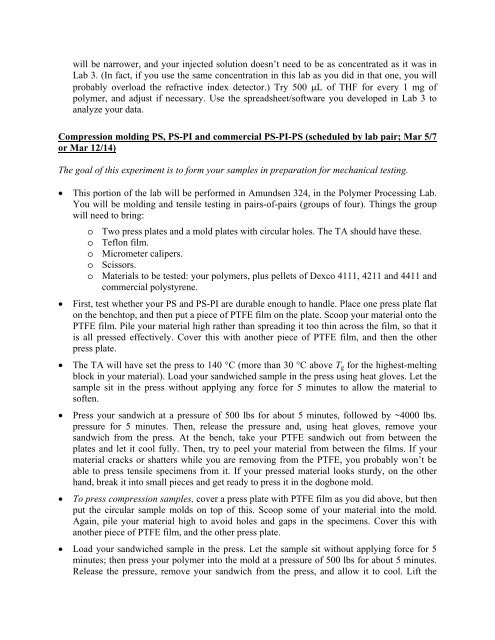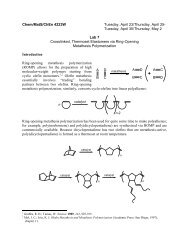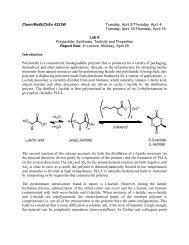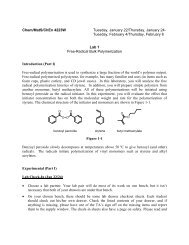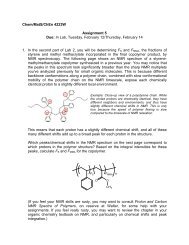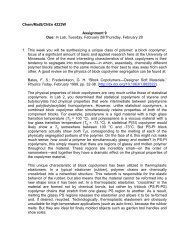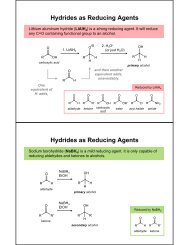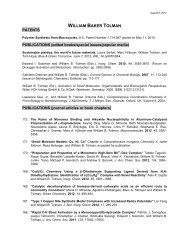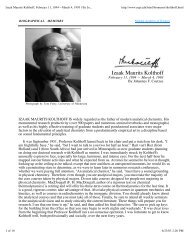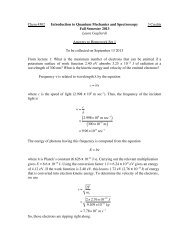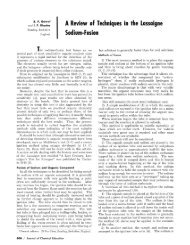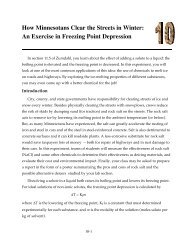Chem/MatS/ChEn 4223W Tuesday, February 26/Thursday, February ...
Chem/MatS/ChEn 4223W Tuesday, February 26/Thursday, February ...
Chem/MatS/ChEn 4223W Tuesday, February 26/Thursday, February ...
Create successful ePaper yourself
Turn your PDF publications into a flip-book with our unique Google optimized e-Paper software.
will be narrower, and your injected solution doesn’t need to be as concentrated as it was inLab 3. (In fact, if you use the same concentration in this lab as you did in that one, you willprobably overload the refractive index detector.) Try 500 L of THF for every 1 mg ofpolymer, and adjust if necessary. Use the spreadsheet/software you developed in Lab 3 toanalyze your data.Compression molding PS, PS-PI and commercial PS-PI-PS (scheduled by lab pair; Mar 5/7or Mar 12/14)The goal of this experiment is to form your samples in preparation for mechanical testing.This portion of the lab will be performed in Amundsen 324, in the Polymer Processing Lab.You will be molding and tensile testing in pairs-of-pairs (groups of four). Things the groupwill need to bring:o Two press plates and a mold plates with circular holes. The TA should have these.o Teflon film.o Micrometer calipers.o Scissors.o Materials to be tested: your polymers, plus pellets of Dexco 4111, 4211 and 4411 andcommercial polystyrene.First, test whether your PS and PS-PI are durable enough to handle. Place one press plate flaton the benchtop, and then put a piece of PTFE film on the plate. Scoop your material onto thePTFE film. Pile your material high rather than spreading it too thin across the film, so that itis all pressed effectively. Cover this with another piece of PTFE film, and then the otherpress plate.The TA will have set the press to 140 °C (more than 30 °C above T g for the highest-meltingblock in your material). Load your sandwiched sample in the press using heat gloves. Let thesample sit in the press without applying any force for 5 minutes to allow the material tosoften.Press your sandwich at a pressure of 500 lbs for about 5 minutes, followed by ~4000 lbs.pressure for 5 minutes. Then, release the pressure and, using heat gloves, remove yoursandwich from the press. At the bench, take your PTFE sandwich out from between theplates and let it cool fully. Then, try to peel your material from between the films. If yourmaterial cracks or shatters while you are removing from the PTFE, you probably won’t beable to press tensile specimens from it. If your pressed material looks sturdy, on the otherhand, break it into small pieces and get ready to press it in the dogbone mold.To press compression samples, cover a press plate with PTFE film as you did above, but thenput the circular sample molds on top of this. Scoop some of your material into the mold.Again, pile your material high to avoid holes and gaps in the specimens. Cover this withanother piece of PTFE film, and the other press plate. Load your sandwiched sample in the press. Let the sample sit without applying force for 5minutes; then press your polymer into the mold at a pressure of 500 lbs for about 5 minutes.Release the pressure, remove your sandwich from the press, and allow it to cool. Lift the


